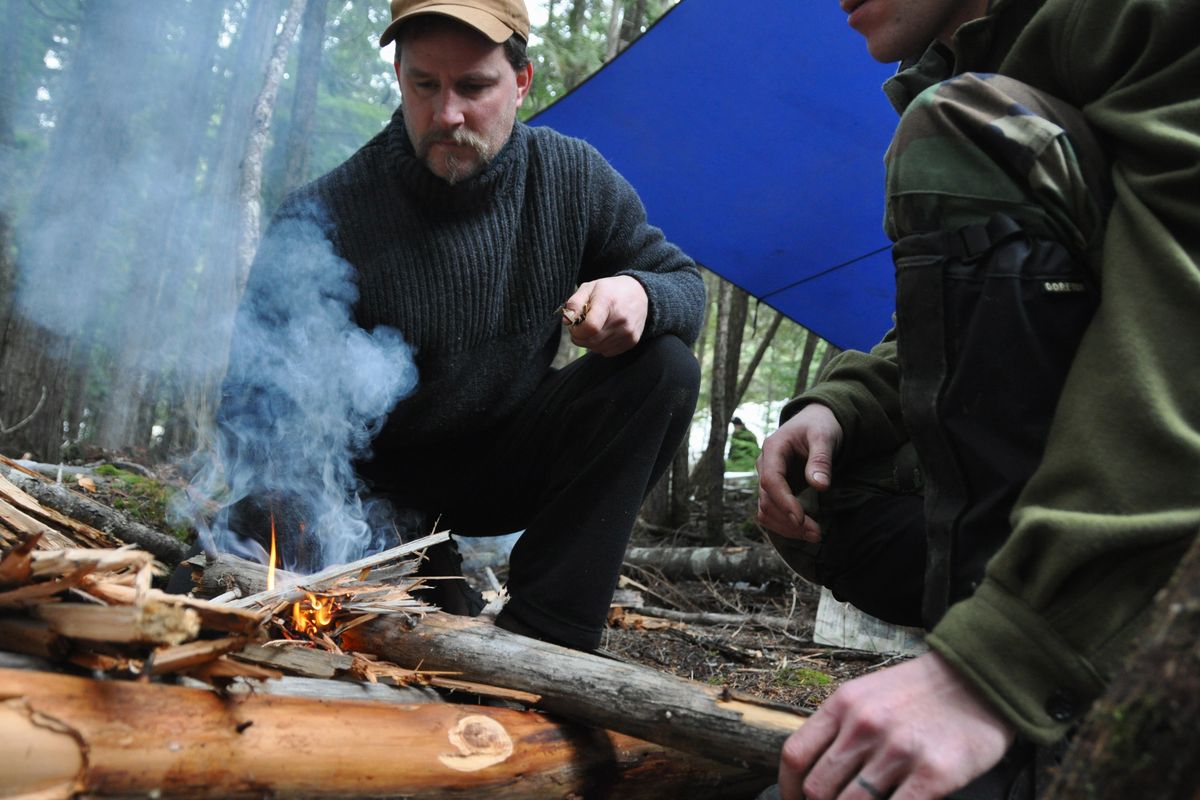Skills to live by
Can you make a fire in a wet forest? Have you tried?

Get out of harm’s way. Shelter yourself from the elements. Build a fire. Signal your location. These basic elements of backcountry survival are easier said than done.
“You can’t just talk about these skills; you have to practice them,” said Sgt. Douglas Dinger of the 336th Training Group’s Survival School at Fairchild Air Force Base.
Dinger and 16 other Survival School experts were not working with an ordinary group last Saturday and Sunday at Priest Lake State Park.
More than 130 people – teenagers to septuagenarians – involved with search and rescue in 20 groups and agencies in the Inland Northwest were camped out through the cold, wet weekend to build their arsenal of survival skills.
“What they learn here is important for themselves, as well as for the victims they may be called to rescue,” said Bob Abbott of the Priest Lake Search and Rescue Team.
“A lot of these people have the basic knowledge of how to take care of themselves and a victim in the wilderness,” Dinger said. “We’re verifying what they know and showing them how to apply it.”
Indeed, everyone who ventures outdoors should practice these skills, he said.
The Air Force instructors are pros at boiling down survival lessons into lean phrases that stick in a student’s mind.
Emergency signaling fundamentals, for instance, are reinforced by three words: size, contrast, movement.
“We don’t have a few ribbons tied up to attract attention, we have a big space blanket hanging from the trees (at the clearing) to move in the breeze and reflect light in contrast with the dark green forest,” he said.
“You can even reflect moonlight from a space blanket or mirror on a very clear, bright night, he said.
Imprinting the three words – size, contrast, movement – helps you remember to litter pine boughs or sticks into a big SOS message stamped in the snow and to add grass, leaves or pitchy wood to improve on a big signal fire by increasing its smoke.
“And the fire should be the biggest containable fire you can sustain,” Dinger said.
“We can watch Bear Grylls and the survival shows on TV, but it’s far different being out here in bad conditions and trying to put survival skills to use.”
Building a fire in wet conditions is among the most basic and important survival skills.
Even the seasoned outdoors types – men and women – attending the training weekend learned something from the instructors’ fire-making seminars.
“It’s funny to realize that virtually all the fires I’ve made have been started with newspaper,” said Josh Stanly, an Idaho Fish and Game conservation officer from Wallace. “This is great practice,” he said as he prepared to build a fire from what he could gather in the damp winter woods after observing a demonstration by a Survival School instructor.
“There’s a false sense of security from all of the high-tech stuff we have nowadays. Even if you have a satellite phone and GPS, things can go wrong and you’ll need these basic skills.
“We just recently had a helicopter go down with Fish and Game employees on board. You never know.”
In the classic Survival School way, instructor Nick Weber had refined fire-making basics into a tried and true progression of 10 steps. (See sidebar.)
Some conditions allow for bypassing some of the steps. However, when the pressure is on – a victim is suffering, a storm is moving in, night is falling – it pays off to strictly follow the recipe for success, he said.
“It would really suck to fail because you missed one step, especially when your fingers are freezing,” he said.
A case in point: Airline pilot Chesley “Sully” Sullenberger credits his pressure-packed adherence to step-by-step procedure for saving his passengers in the “miracle on the Hudson River” crash landing last year.
Essential survival items should be in a person’s pocket or pack anytime he goes into the mountains, Weber said.
Indeed, outdoors groups, such as the Spokane Mountaineers, preach a list of 10-13 “essentials” they require people to bring for participation in club outings. (See sidebar.)
Search and rescue team members have day packs and three-day packs preassembled with required survival and medical items and ready to go at a moment’s notice.
But having the gear isn’t enough, Weber said. “You have to practice using it.”
Cotton balls coated in petroleum jelly and stored in a waterproof container or zipper-type plastic bag should be in everyone’s pack or pocket, Weber said.
“This is the most popular fire starter because it’s cheap, easy and effective,” he said. “But you can still screw it up.”
While pointing out that you can have to too much or too little petroleum jelly on the cotton, the key is to enhance the cotton “ball” into a bigger cotton “creature” with multiple appendages before igniting it.
Weber showed how to pull the Vaseline-coated cotton ball apart like peaks on meringue. He stroked each cotton tuft with jelly between his thumb and forefinger – just enough to coat the tuft while leaving it fibrous.
Then, with one match, a flick of a Bic, or a single knife stroke down a magnesium fire-starting tool, the Vaseline-treated cotton burned a tall flame for minutes – much bigger, hotter and longer than if he had torched the original coated cotton ball.
“Practice makes perfect,” he said.